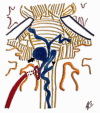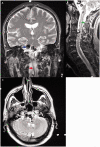A new subtype of intracranial dural AVF according to the patterns of venous drainage
- PMID: 33023355
- PMCID: PMC7903550
- DOI: 10.1177/1591019920963816
A new subtype of intracranial dural AVF according to the patterns of venous drainage
Abstract
Background and purpose: A well-known classification of dural arteriovenous fistulas (DAVFs) according to the patterns of venous drainage was described in 1977 by Djindjian, Merland et al. and later revised by Cognard, Merland et al. in 1995. They described 5 types of DAVFs assuming that the type of venous drainage is directly correlated with neurologic symptoms and in particular with hemorrhagic risk. We present a series of cases that combines type IV (DAVF with cortical venous drainage associated with venous ectasia) and type V (DAVF with spinal venous drainage), which we named type IV + V.
Materials and methods: A retrospective study between 2012 and 2020 in 2 Hospitals was performed on patients that met inclusion criteria for a diagnosis of this type of DAVF. Demographics, location, clinical presentation and outcomes of endovascular embolization were studied.
Results: Five (2,3%) patients out of 220 had a type IV + V DAVF. All cases had an aggressive presentation, either subarachnoid hemorrhage, myelopathy or both. All patients were treated with endovascular transarterial embolization achieving complete angiographic occlusion in one session and total remission of symptoms at 3 months.
Conclusions: This rare type of DAVF, combines two aggressive venous drainage patterns. For that reason, patients with type IV+V DAVF probably have a more aggressive natural history and worst outcome due to risk of intracranial and/or spinal hemorrhage and myelopathy, thus requiring urgent diagnostic and treatment. Larger studies are needed to better understand this type of DAVF.
Keywords: Intracranial hemorrhage; dural arteriovenous fistula; myelopathy.
Conflict of interest statement
Figures





References
-
- Newton TH, Weidner W, Greitz T. Involvement of the dural arteries in intra-cranial arteriovenous malformations. Radiology 1968; 90: 27–35. - PubMed
-
- Djindjian R, Merland JJ, Theron J. Superselective arteriography of the external carotid artery. New York, NY: Springer-Verlag, 1977, pp.606–628.
-
- Cognard C, Gobin YP, Pierot L, et al. Cerebral dural arteriovenous fistulas: clinical and angiographic correlation with a revised classification of venous drainage. Radiology 1995; 194: 671–680. - PubMed
-
- Gomez J, Amin AG, Gregg L, et al. Classification schemes of cranial dural arteriovenous fistulas. Neurosurg Clin N Am 2012; 23: 55–62. - PubMed
MeSH terms
LinkOut - more resources
Full Text Sources
Miscellaneous

